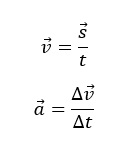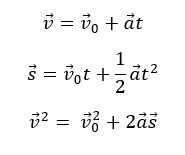 A pair of F-16C Fighting Falcons, assigned to the 27th Fighter Wing, Cannon Air Force Base, N.M., Image
courtesy U.S. Air Force photo by Tech. Sgt. Kevin Gruenwald
A pair of F-16C Fighting Falcons, assigned to the 27th Fighter Wing, Cannon Air Force Base, N.M., Image
courtesy U.S. Air Force photo by Tech. Sgt. Kevin Gruenwald
|
|
In uniform motion, an object has a constant velocity; that is a constant 'speed' in a straight line.
(note, that speed may be positive (going forward), negative (going backward) or stationary).
Velocity and acceleration are 'vector' quantities; they have both a magnitude and a direction
Since velocity and acceleration are vectors, we can say that the velocity or the acceleration of an
object has changed if either the magnitude or the direction changes
The definition of 'average velocity' and 'average acceleration' are used as the building blocks for our
key 'classical physics motion equations'

Motion can be analysed using displacement/time (s/t) graphs, velocity/time (v/t) and acceleration/time graphs (a/t)
Of note, calculus was invented for use in analysing equations of motion
The constant acceleration due to gravity near the surface of the Earth is approximately g=9.80ms-2
Motion under a constant acceleration can be analysed using the following 3 equations

All physics calculations use SI units (metres (m), seconds (s), kilograms (kg)).
Lectures
Lecture - Motion under constant acceleration
Videos
Crash course, Motion in a straight line
Matt Anderson, Motion diagrams
The maths of physics - you need to watch this
Derivatives: Crash Course Physics #2
Integrals: Crash Course Physics #3
|
|
Home page /
Stage 1 home page /
Linear motion home page
|
|


